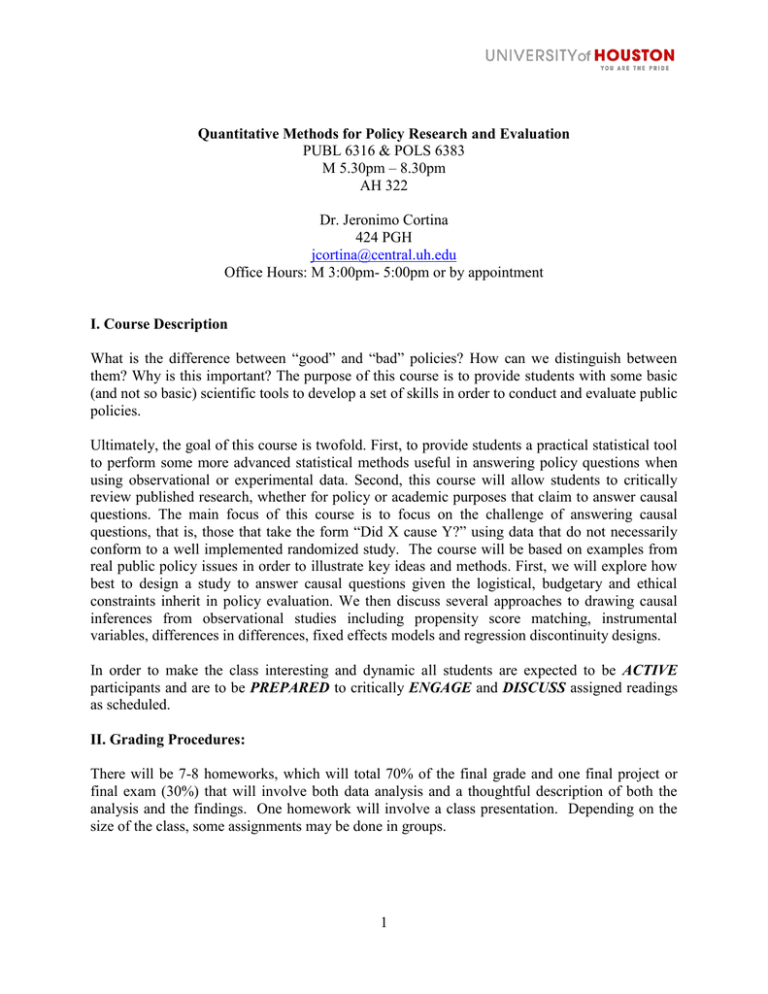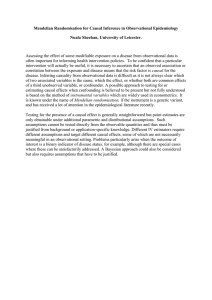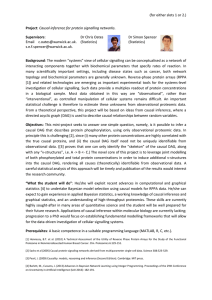PUBL 6316 & POLS 6383 M 5.30pm – 8.30pm AH 322
advertisement

Quantitative Methods for Policy Research and Evaluation PUBL 6316 & POLS 6383 M 5.30pm – 8.30pm AH 322 Dr. Jeronimo Cortina 424 PGH jcortina@central.uh.edu Office Hours: M 3:00pm- 5:00pm or by appointment I. Course Description What is the difference between ―good‖ and ―bad‖ policies? How can we distinguish between them? Why is this important? The purpose of this course is to provide students with some basic (and not so basic) scientific tools to develop a set of skills in order to conduct and evaluate public policies. Ultimately, the goal of this course is twofold. First, to provide students a practical statistical tool to perform some more advanced statistical methods useful in answering policy questions when using observational or experimental data. Second, this course will allow students to critically review published research, whether for policy or academic purposes that claim to answer causal questions. The main focus of this course is to focus on the challenge of answering causal questions, that is, those that take the form ―Did X cause Y?‖ using data that do not necessarily conform to a well implemented randomized study. The course will be based on examples from real public policy issues in order to illustrate key ideas and methods. First, we will explore how best to design a study to answer causal questions given the logistical, budgetary and ethical constraints inherit in policy evaluation. We then discuss several approaches to drawing causal inferences from observational studies including propensity score matching, instrumental variables, differences in differences, fixed effects models and regression discontinuity designs. In order to make the class interesting and dynamic all students are expected to be ACTIVE participants and are to be PREPARED to critically ENGAGE and DISCUSS assigned readings as scheduled. II. Grading Procedures: There will be 7-8 homeworks, which will total 70% of the final grade and one final project or final exam (30%) that will involve both data analysis and a thoughtful description of both the analysis and the findings. One homework will involve a class presentation. Depending on the size of the class, some assignments may be done in groups. 1 Final letter grades will be calculated using the following percentages: 95-100% = A 90-94 = A- 87-89 = B+ 84-86 = B 80-83 = B- 77-79 = C+ 74-76 = C 70-73 = C- 67-69 = D+ 64-66 = D 60-63 = D59 or less = F III. Course Outline The following outline describes the topics that will be covered and its readings. Those readings marked with an * are recommended, and thus not required. Some of the reading assignments might change in case that there is a more appropriate reading (there will be a class announcement to indicate if a reading has been change with enough time in advance). Readings are available in Jstor or their respective Journal (through MD Anderson Library) or will be at Blackboard. Session 1: Review Session and Introduction to Causal Inference *Cortina, Jeronimo. 2009. "To Treat or not to Treat: Causal Inference in the Social Sciences." In A Quantitative Tour of the Social Sciences, ed. A. Gelman and J. Cortina. New York: Cambridge University Press. *Hill, Jennifer., Reiter, Jerome., and Zanutto, Elaine. (2004) ―A comparison of experimental and observational data analyses‖ Applied Bayesian Modeling and Causal Inference from an Incomplete-Data Perspective. Edited by Andrew Gelman and Xiao-Li Meng. West Sussex, England: Wiley. *Leamer, Edward (1983) "Let's take the con out of econometrics", American Economic Review, 73(1): 31-43 *Hill, J. (2004) ―Evaluating School Choice Programs‖ forthcoming in Statistics: A Guide to the Unknown edited by Hal Stern et al. *Holland, Paul W. (1986), ``Statistics and causal inference (with discussion)'', Journal of the American Statistical Association, 81: 945-970 *Sobel, M. ―Causal Inference in the Social and Behavioral Sciences‖ in Handbook of Statistical Modeling for the Social and Behavioral Sciences. pp. 1-38 2 Session 2: Randomized Experiments and the Rubin Causal Model Katz, L.F., Kling, J.R., and Liebman, J.B. (2001) ―Moving to Opportunity in Boston: Early Results of a Randomized Mobility Experiment‖ The Quarterly Journal of Economics 116: 607-654. Winship, Christopher and Michael Sobel (2004) ―Causal Inference in Sociological Studies‖ in Handbook of Data Analysis edited by Melissa Hardy and Alan Bryman, London: Sage Publications, 481-504 – the version you’ll see is number 1-63 and you’ll be responsible through p. 25 for this week *Rosenbaum, P. (2002) Observational Studies, 2nd ed., New York: Springer, Chapter 2 *Rubin, D. (1990) ―Formal modes of statistical inference for causal effects‖ Journal of Statistical Planning and Inference 25: 279-292. (available through e-journals) *Rubin, DB (1974) "Estimating Causal Effects of Treatments in Randomized and NonRandomized Studies" Journal of Educational Psychology, 66: 688-701 *Sobel, Michael E. (1996), ―An introduction to causal inference‖, Sociological Methods and Research, Vol. 24, Iss. 3; p. 353-379 Session 3: Observational Studies Rosenbaum, P. (2002) Observational Studies, 2nd ed., New York: Springer, Chapter 1 Winship, Christopher and Michael Sobel (2004) ―Causal Inference in Sociological Studies‖ in Handbook of Data Analysis edited by Melissa Hardy and Alan Bryman, London: Sage Publications, 481-504 – the version you’ll see is number 1-63 and you’ll be responsible for 36-38 for this week Donohue, J. J., and S.D. Levitt (2001) ―The impact of legalized abortion on crime‖ The Quarterly Journal of Economics, 116(2): 379-420 *Rubin, D. (1977) ―Assignment to Treatment Groups on the Basis of a Covariate‖ Journal of Educational Statistics, 2: 1-26 *LaLonde, R. (1986) Evaluating the Econometric Evaluations of Training Programs, American Economic Review, 76: 604-620 *Rosenbaum, P. (2002) ―Covariance adjustment in randomized experiments and observational studies‖, Statistical Science, 17(3): 286-327 *William G. Cochran and Donald B. Rubin, (1973) "Controlling Bias in Observational Studies: A Review", Sankhya, 35: 417-446 (LL) 3 Session 4: Propensity Score - Theory Rosenbaum, PR and D B. Rubin (1985) "Constructing a control group using multivariate matched sampling methods that incorporate the propensity score", The American Statistician, 39: 33-38 Kam, Cindy D., and Carl L. Palmer. 2008. "Reconsidering the Effects of Education on Political Participation." The Journal of Politics 70 (3):612-31. *Rosenbaum, Paul R. and Rubin, Donald B. (1984) "Reducing Bias in Observational Studies Using Subclassification on the Propensity Score" Journal of the American Statistical Association, 79: 516—524 Session 5: Propensity Score– Practice D’Agostino, R (1998) "Propensity score methods for bias reduction in the comparison of a treatment to a non-randomized control group" Statistics in Medicine, 17: 2265-2281. Hill J, Waldfogel J, Brooks-Gunn J (2002) ―Differential effects of high-quality child care‖ Journal of Policy Analysis and Management, 21 (4): 601-627 *Foster, M. ―Propensity Score Matching: An Illustrative Analysis of Dose Response‖ forthcoming in Medical Care Session 6: Propensity Score Wrap-Up Dehejia, Rajeev H. and Wahba, Sadek (1999) "Causal Effects in Nonexperimental Studies: Reevaluating the Evaluation of Training Programs", Journal of the American Statistical Association, 94: 1053—1062 Session 7: Instrumental Variables Models – Introduction and Theory Angrist, J D. (1990) "Lifetime Earnings and the Vietnam Era Draft Lottery: Evidence from Social Security Administrative Records," American Economic Review, 80: 313-336 Angrist, J D., Imbens, G W. and D B. Rubin, (1996) " Identification of Causal Effects Using Instrumental Variables," Journal of the American Statistical Association, 91: 444-472 *Wooldridge, J. M. (2003) Introductory Econometrics Chapter 15 (LL) 4 Session 8: Instrumental Variables Models – Practice (Stata) Angrist JD, Evans WN (1998), "Children and their parents' labor supply: Evidence from exogenous variation in family size", American Economic Review 88(3): 450-77 *E Michael Foster. (2000) ―Is more better than less? An analysis of children’s mental health services‖ Health Services Research. Chicago: Vol. 35, Iss. 5; p. 1135 *Levitt, Steven D. 1996. ―The Effect of Prison Population Size on Crime Rates: Evidence from Prison Overcrowding Litigation.‖ Quarterly Journal of Economics, 111(2): 319-51. Session 9: Difference in Differences Chapter 18 on Panel Data Model in Ashenfelter book Statistics and Econometrics (published by Wiley, 2003), pp. 262-273 Angrist, J. D., and Krueger, A. (1999), ―Empirical Strategies in Labor Economics,‖ in Orley Ashenfelter and David Card (eds), Handbook of Labor Economics, Vol. 3A, Amsterdam: HorthHolland, A version is available online at http://www.irs.princeton.edu/pubs/pdfs/401.pdf ONLY PP 19-23 Bogart & Cromwell. ―How much is a neighborhood worth?‖ J. Urban Economics 47 *Card, D. and A. Krueger (1994) ―Minimum Wages and Employment: A Case Study of the Fastfood Industry in New Jersey and Pennsylvania,‖ American Economic Review, 84(4): 772-784. *Meyer, B. (1995) ―Natural and Quasi-Experiments in Economics,‖ Journal of Business and Economic Statistics, 13(2): 151-161 Session 10: Fixed Effects Aaronson, Daniel. (1998) "Using Sibling Data to Estimate the Impact of Neighborhoods on Children's Educational Outcomes" The Journal of Human Resources, 33(4): 915-946 *Korenman and Neumark (1991) "Does Marriage Really Make Men More Productive?" Journal of Human Resources, 26(2): 282-307 *Chay, K. and Greenstone, M. (2003) ―The Impact of Air Pollution on Infant Mortality: Evidence from Geographic Variation in Pollution Shocks Induced By A Recession‖ Quarterly Journal of Economics 118(3): 1121-1167. 5 Session 11: Regression Discontinuity Brian A. Jacob, Lars Lefgren (2004) ―Remedial Education and Student Achievement: A Regression-Discontinuity Analysis‖ Review of Economics and Statistics 86(1) Session 12: Structural Equations Modeling (SEM), Path Analysis Holland, P. (1988) ―Causal Inference, Path Analysis, and Recursive Structural Equation Models‖ Sociological Methodology, 18: 449-493 Session 13: Wrap-Up Additional reading that could be helpful at some point: *Over, M. and D. Jolliffe and A. Foster (1995) "Huber correction for two-stage least squares estimates," Stata Technical Bulletin, 29: 24-25 (Reprinted in Stata Technical Bulletin Reprints, vol.5, p.140-142) *Bound, J, Jaeger, D.A., Baker, R.M. (1995) "Problems with instrumental variables estimation when the correlation between the instruments and the endogenous explanatory variable is weak" Journal of the American Statistical Association, 90: 443-450. IV. Academic Integrity Cheating and plagiarism will not be tolerated and will result in a grade penalty or failure of the course. Each student in this course is expected to abide by the University of Houston’s policies against cheating and plagiarism. The University’s statement on academic honesty is available from the student handbook, which can be found at http://www.uh.edu/dos/pdf/2009-2010StudentHandbook.pdf You are encouraged to work, study together and to discuss information and concepts covered in lectures and the sections with other students. You can give "consulting" help to or receive "consulting" help from such students. However, this permissible cooperation should never involve one student having possession of a copy of all or part of work done by someone else, in the form of an e-mail, an e-mail attachment file, a diskette, or a hard copy. Should copying occur, both the student who copied work from another student and the student who gave material to be copied will both automatically receive a zero for the assignment (this applies to homework, exams, quizzes, etc.). Penalty for violation of this Code can also be extended to include failure of the course and University disciplinary action. During examinations, you must do your own work. Talking or discussion is not permitted during the examinations, nor may you compare papers, copy from others, or collaborate in any way. Any collaborative behavior during the examinations will result in failure of the exam, and may lead to failure of the course and University disciplinary action. 6 V. Accommodations for students with disabilities The University of Houston is committed to providing reasonable accommodations for eligible students with disabilities, including students who have learning disabilities, health impairments, psychiatric disabilities, and/or other disabilities. If you believe you have a disability which requires accommodation, please contact the Center for Students with Disabilities (CSD) at 713743-5400 voice or 713-749-1527 (TTY) VI. Cell Phones, Beepers & Laptops Since they cause interruptions and distractions, cell phones and beepers should be turned off during class time. Please do not use any Instant Messaging software if you bring your laptop to take notes. In particular, no cell phones, beepers and laptops may be accessible during exams. 7




